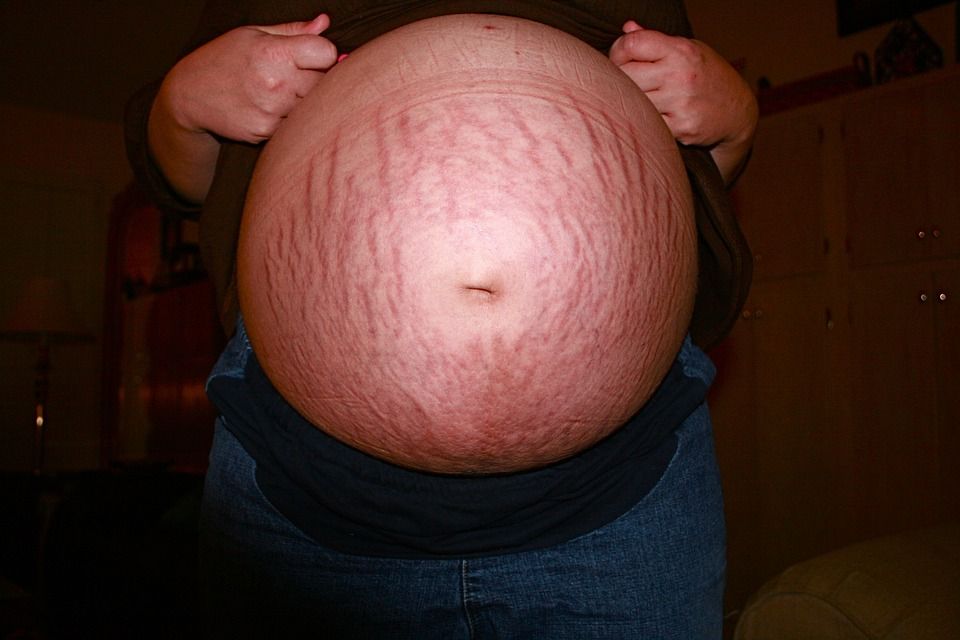Stretch marks are triggered by rapid growth, indicating how it affects collagen. Collagen is the most abundant protein in the body found in bones, muscles, skin, and tendons. It’s the substance that holds the body together, giving the appearance of smooth and bouncy skin. However, collagen production lowers as you get older, and collagen on the skin can be over-stretched by rapid growth or weight gain.
When collagen on the skin is stretched beyond its limit, you can get fractures within the connected tissue. That forms the stretch marks. It’s found in the deep area of the skin – the dermis.
For most women, stretch marks are unwelcome scars in the body that we’d like to simply disappear. They can pop up all over the body, with the most common areas, including the belly, thighs, and chest area. While some ladies are proud to show off their stretch marks as a symbol of motherhood, others actively search for ways to get rid of them. Here are some things you can do to reduce the appearance of stretch marks:
Lotions and gels
Researchers studied many of the lotions, gels, and creams that are sold to treat stretch marks. Products with shea butter, olive oil, vitamin E oil, and cocoa butter are your best choices. While no one product seems to help all of the time (some doesn’t even help at all), but there are some helpful hacks to make them more effective.
- Make sure to use them on early stretch marks. These topical treatments may have little effect on mature stretch marks.
- Take time to massage the product into your stretch marks so that it can be better absorbed by your skin, making it more effective.
- Use the product every day for weeks for the best results.
Home remedies
If you aren’t into chemicals, try the natural route. Some home remedies can help reduce the appearance of stretch marks.
Aloe vera
This plant has miraculous healing properties for the skin. Simply take the fresh gel from the leaf and massage it to the area with stretch marks. Leave it on for 20-30 minutes. Do this daily and wash it off with tepid water.
Cocoa butter
Cocoa butter is effective for reducing stretch marks. When used during and after pregnancy, it helps make stretch marks disappear completely. It’s best to apply during the night, so massage it well into the skin, and over a period of time, you will find the stretch marks fading away.
Almond and coconut oil
Use both almond oil and coconut oil in equal amounts to reduce stretch marks. Massage them unto the skin regularly. This natural alternative doesn’t have any harmful side effects, so if you massage it to affected skin religiously, you will see effective results.
Natural nourishing skin mask
This homemade skin mask mixture works incredibly in reducing stretch marks. Mix 2 egg yolks, lemon juice, two tablespoon oatmeal, two tablespoon almond paste. Add just enough milk to mix them into a smooth paste. Apply the mixture on your stretch marks and wait for it to dry completely. Wash off with cold water and gently rub the skin. This must be done every other day.
Prescription medicines
There are some prescription medicines that you can apply to your skin.
Hyaluronic acid
Hyaluronic acid is a well-known moisturizing ingredient, as it works well for alleviating dry skin, reducing the appearance of fine lines, and speeding up the healing of wounds. These are applied to early stretch marks, making them less noticeable.
Tretinoin
Tretinoin contains retinoid, a compound related to Vitamin A. It increases collagen production and helps fade newer stretch marks. According to one study, people who applied retinoid creams every night for 24 weeks had less noticeable stretch marks.
Retinol
Also known as vitamin A, retinol works to stimulate collagen production to smoothen fine lines, blurring acne marks, and other blemishes like stretch marks. It helps fade early stretch marks over continued use.
Dermatology procedures
Dermatologists and plastic surgeons can perform treatments to help fade stretch marks quicker, although none can get rid of stretch marks completely. A dermatologist may use more than once a procedure. Here are some of the procedures that can be done:
Pulsed dye laser therapy
This is a painless blast of laser therapy used on new, red stretch marks. The energy from the light calms the blood vessels under the skin that causes the marks.
Fractional CO2 laser therapy
This is one of the latest advancements in skin rejuvenation treatments. This procedure can help smooth out old, white stretch marks. A study showed that women’s stretch marks faded after five sessions of this laser therapy as compared to those who used topical creams with tretinoin and glycolic acid.
Microdermabrasion
This is a painless procedure that uses tiny crystals to rub off the top layer of the skin. It can help reduce the appearance of old, white stretch marks as it targets the upper layer of the skin and stimulating the skin to tighten the collagen and elastin fibers. It can also help fade new, reddish stretch marks when treated with skin peels.
Microneedling
Microneedling targets the dermis, the middle layer of the skin where stretch marks form. It uses tiny needles poked into the skin to trigger collagen production. This is a great option for those with darker skin tones, as laser-based treatments may cause hyperpigmentation.
Radiofrequency
Radiofrequency (RF) skin resurfacing treatments use RF technology to deliver heat energy to the dermis and trigger the skin’s natural collagen production in that area. It’s effective for both early to late-stage stretch marks.
Cosmetic surgery
Cosmetic surgery is the most expensive yet effective option for removing stretch marks from the body. A surgery called tummy tuck, which removes excess skin and fat from the abdomen, also removes the skin with stretch marks. It gives the abdomen a flatter look. However. This procedure may leave surgery scars on its own.

